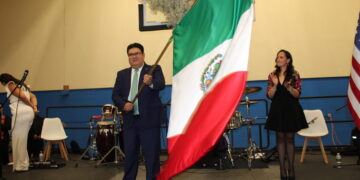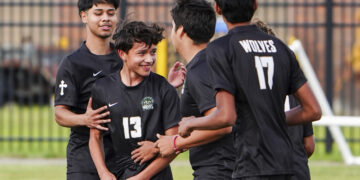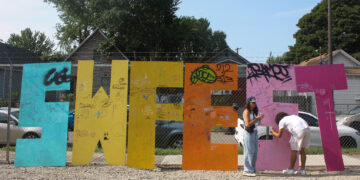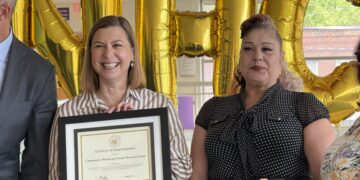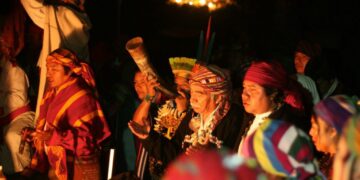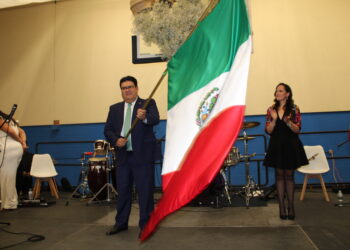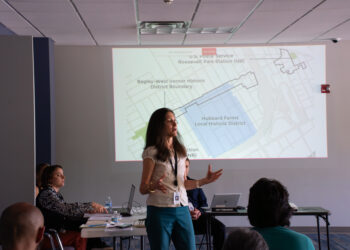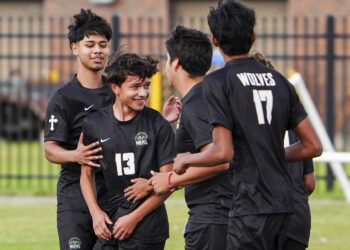The Tzotzils (Tsotsils) are a Mayan community that inhabits the Highlands region of Chiapas and some municipalities in the surrounding area. The Tzotzils call themselves Batsi’i Winik’otik, meaning “true men,” and they speak Batsil K’op, meaning “true language” or “legitimate language.” With nearly 400 people speaking their native Tzotzil, which is often the only language they speak in order to preserve their culture and language, there are also bilingual people who speak Spanish.
The Tzotzil people are located in several municipalities in the state of Chiapas: Zinacantán, San Juan Chamula, San Andrés Larráinzar, Chenalhó, Pantelhó, Huitiupán, Chalchihuitán, El Bosque, Simojovel, Ixtapa, Bochil, Soyaló, Huixtán, San Lucas, Acala, San Cristóbal de las Casas, Venustiano Carranza (San Bartolomé de los Llanos), Mitontic, Rayón, and Amatán.
The Tzotzil are known for their weaving, their wool skirts, and the way they govern their communities, particularly San Juan Chamula.
The word Tzotzil derives from sots’il winik, which means “bat man.” It is said that the ancestors of the Zinacantecos found a bat in that valley and took it for God.
The Tzotzil population is organized into communities, which are in turn divided into neighborhoods. Each community has a ceremonial center, its own clothing, a main local patron saint, and a specific economic specialty.

The basic structure is the family, composed of mother, father, and children. If the sons marry, they may bring their wives and children to the same dwelling, thus forming extended families of up to three generations. Old age is a sign of authority; thus, the oldest man in the house controls the group, owns the land, and organizes agricultural activities.
The Tzotzil language comes from Proto-Ch’ol, a language spoken in the Late Classic Period at sites such as Palenque and Yaxchilán.
The Tzotzil have migrated in search of land due to political and religious conflicts within and outside the state of Chiapas, as well as for studies and the search for other economic niches than those offered by their communities. This has led to communities of Tzotzil speakers being found throughout the state of Chiapas, Mexico, and the United States of America, especially in Illinois.
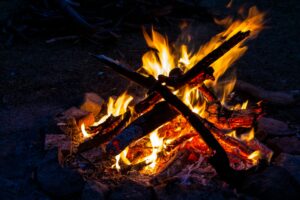
How Fire Protected Humans
Long ago, no one knows how long ago, our ancestors said that fire was the spirit of a god. They say that once upon a time, a human being left his home and headed toward a great mountain to hunt animals. As he entered the mountain, it began to cloud over, and the human being continued on his way until, suddenly, he realized he was already inside the mountain. So he began to worry and began searching for his way back home. No matter how hard he looked, he couldn’t find it. Then, he realized that night was falling and began to tremble with fear. Suddenly, he heard someone calling him:
“Lord, Lord, do not be afraid! Don’t you see that I am here to help you?” said the little voice, and he realized it was the little voice of fire, which spoke to him again:
“Look for my food; if you don’t look for it, I won’t be able to watch you at night.”
The food that the fire wanted was firewood, and so the human being began to look for his firewood. When it was already very night, he set fire to the wood. When the fire ignited, it warmed the human, so he no longer noticed anything and fell asleep.
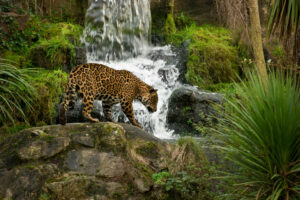
Suddenly, a very large jaguar appeared from between the trees. It approached the human’s left foot and said:
“I’m going to eat you!”
The toe replied:
“No, because I’m not going to die like this!”
And the jaguar didn’t give up, and it approached the fire
and also said to it:
“I’m going to eat the human who is at your side!”
And the fire replied:
“No! Because he is my master, and I am his guardian while he rests.”
And the jaguar, so angry was he at the fire’s response, quickly invented something else and spoke again:
“If you don’t let me eat the human, I’m going to urinate on you and put you out, so I can eat the human without having to deal with you.”
The fire remained silent, but suddenly said:
“You can eat the human, but on one condition.”
“What?” said the jaguar.
“If you can jump over me three times, you can eat the human.”
And the jaguar began to laugh because the fire was almost gone because of the cold. That’s how the lion began to jump over the fire. On the first jump, the fire became very happy because it had something in mind. On the second jump, the fire proved what it was thinking and stood up, but it couldn’t. On the third jump, the fire jumped right up to the jaguar and chased him up the mountain.
They say that when the human woke up, he realized that everything was burned and that the mountain was burned too. The human climbed up the great mountain and found the jaguar lying there, and that’s why jaguars have their spots. Since then, the jaguar has no faith in fire, so it always lives near water.
Los tzotziles (tsotsiles) son una comunidad mayense que habitan la región de los Altos de Chiapas y algunos municipios del área colindante. Los tzotziles se llaman a sí mismos batsiI winik’otik: “hombres verdaderos”, hablan el batsil k’op: “lengua verdadera” o “lengua legítima”. Con cerca de cuatrocientos miel hablantes de lengua materna tzotzil y que en comúnmente es la única lengua que hablan en aras de preservar su cultura e idioma, también hay bilingües, que también hablan el español.
El Pueblo Tsotsil está ubicada en varios municipios del estado de Chiapas: Zinacantán, San Juan Chamula, San Andrés Larráinzar, Chenalhó, Pantelhó, Huitiupán, Chalchihuitán, El Bosque, Simojovel, Ixtapa, Bochil, Soyaló, Huixtán, San Lucas, Acala, San Cristóbal de las Casas, Venustiano Carranza (San Bartolomé de los Llanos), Mitontic, Rayón y Amatán.
Los Tsotsiles son conocidos por sus trabajos de telar, sus faldas de lana y por cómo rigen sus comunidades, principalmente, San Juan Chamula.
El vocablo tzotzil deriva de sots’il winik, que significa “hombre murciélago”. Se cuenta que los antepasados de los zinacantecos hallaron un murciélago en aquella vega y lo tomaron por Dios.
La población Tzotzil se encuentra organizada en comunidades que a su vez están divididas en barrios. Cada comunidad posee un centro ceremonial, indumentaria propia, un santo patrón local principal y una especialidad económica dentro del conjunto.

La estructura básica es la familia, compuesta por madre, padre e hijos. Si los hijos se casan, podrán llevar a sus esposas e hijos a la misma vivienda, formando así familias extensas de hasta tres generaciones. La vejez es signo de autoridad, así, el hombre de mayor edad en la casa es quien controla al grupo, es dueño de las tierras y organiza las actividades agrícolas.
La lengua Tzotzil procede del proto-Ch’ol, lenguaje hablado en el período clásico tardío en sitios como Palenque y Yaxchilán.
Los tsotsiles han migrado en búsqueda de tierras por conflictos políticos y religiosos dentro y fuera del estado de Chiapas, así como por estudios y búsqueda de otros nichos económicos que aquellos que sus comunidades les ofertan, lo que ha provocado que encontremos comunidades de hablantes del tsotsil en todo el estado de Chiapas, México y Estados Unidos de Norte América, sobre todo en Illinois.

De cómo el fuego protegió a los humanos
Hace mucho tiempo, no se sabe cuánto, dicen nuestros antepasados que el fuego era el espíritu de un dios. Cuentan que había una vez un humano que salió de su casa y que se dirigió rumbo a una gran montaña para cazar animales. Al entrar en la montaña empezó a nublarse y el humano siguió su marcha hasta que, de pronto, se dio cuenta que ya estaba en el interior de la montaña. Fue así que comenzó a preocuparse y empezó a buscar su camino para regresar a su casa. Por más que lo buscaba no lo encontraba. Entonces, se dio cuenta que anochecía y empezó a temblar de miedo. De repente escuchó que alguien lo llamaba:
−¡Señor, señor, no temas! ¿no ves que estoy aquí para ayudarte?− decía la vocecita, y se dio cuenta que era la vocecita del fuego, la cual le volvió a hablar otra vez:
−Busca mi comida, si no la buscas no te podré vigilar en la noche.
La comida que quería el fuego era, pues, la leña, y así fue como el humano comenzó a buscar su leña. Cuando ya era muy noche él le prendió fuego a la leña. Cuando el fuego se levantaba le daba calor al humano, entonces él ya no se daba cuenta de nada y se dormía.

De pronto salió entre los árboles un jaguar muy grande. Y se acercó al pie izquierdo del humano y le dijo:
−¡Te voy a comer!
El dedito del pie contestó:
−¡No, Porque no voy a morir así!
Y el jaguar no se dio por vencido, y se acercó al fuego
y a éste le dijo también:
−¡Voy a comer al humano que está a tu lado!
Y el fuego respondió:
−¡No! Porque es mi amo y soy el guardián de él mientras descansa.
Y el jaguar por tan enojado que estaba por la respuesta del fuego rápidamente inventó otra cosa y habló otra vez:
−Si no me dejas a que lo coma al humano te voy a orinar y te apagaré, así podré comer al humano sin lidiar contigo.
El fuego se quedó callado, pero, de repente, dijo:
−Puedes comer al humano, pero con una condición.
−¿Qué? −dijo el jaguar.
−Si logras saltar tres veces sobre mí, si te podrás comer al humano.
Y el jaguar se puso a reír porque del fuego ya quedaba muy poquito a causa del frío. Así fue como el león comenzó a dar su brinco sobre el fuego. En el primer brinco que dio, el fuego se puso muy contento porque pensaba algo. En el segundo brinco el fuego probó lo que pensaba y se levantó, pero no pudo hacerlo. En el tercer brinco el fuego saltó junto hacia el jaguar y lo fue persiguiendo hasta la montaña.
Cuentan que cuando se despertó el humano se dio cuenta que todo estaba quemado y que la montaña también estaba quemada, y el humano subió hasta la gran montaña y ahí encontró tendido al jaguar, y es por eso que los jaguares tienen sus manchas. Desde entonces, el jaguar no confía en el fuego, por eso siempre vive cerca del agua.

